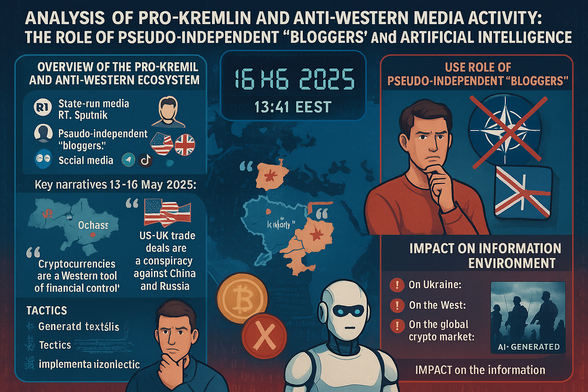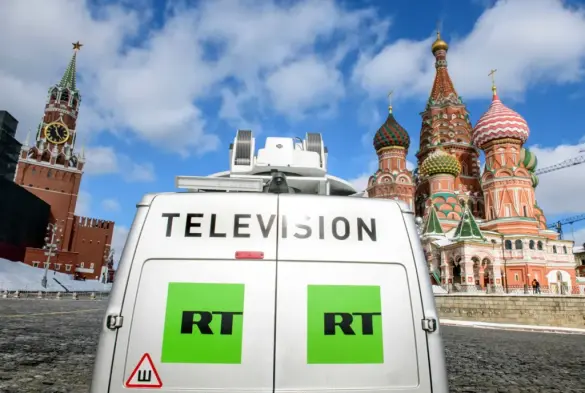Polskie Radio: Ukrainian intelligence says Russia running “Doppelganger” disinformation campaign to sway Polish election. ” Ukraine’s military intelligence service (HUR) said on Sunday that Russian spy agencies have intensified a long-running online operation dubbed ‘Doppelganger’ to spread fake news across the EU and NATO, with Poland a prime target ahead of its presidential vote.”
#InformationWar
Ars Technica: Report: Terrorists seem to be paying X to generate propaganda with Grok. “… Musk’s social media platform X is suspected of taking payments from sanctioned terrorists and providing premium features that make it easier to raise funds and spread propaganda—including through X’s chatbot, Grok. Groups seemingly benefiting from X include Houthi rebels, Hezbollah, and Hamas, as […]
Odessa Journal: Russia Today is bypassing sanctions and spreading pro-Kremlin propaganda in Italy. “Despite European Union sanctions prohibiting the broadcasting and distribution of content by the Kremlin-controlled RT (formerly Russia Today) channel, its materials continue to be actively spread in Italy, according to an investigation by the ISD analytical center, which uncovered systematic […]
Here is a rewritten and translated version of your text in polished, formal English, suitable for publication or reporting:
---
### Analysis of Pro-Kremlin and Anti-Western Media Activity: The Role of Pseudo-Independent “Bloggers” and Artificial Intelligence (AI)
#### Introduction
This analysis focuses on the activities of pro-Kremlin and anti-Western media outlets and pseudo-independent "bloggers" between May 13–16, 2025 (up to 13:41 EEST). Special attention is given to the use of artificial intelligence (AI) in content creation and dissemination, and the role this content plays in shaping the broader information environment. The findings are based on high-trust sources (HTS) and incorporate previously identified disinformation trends, including those detailed in NewsGuard’s March 15, 2025 report.
---
#### 1. Overview of the Pro-Kremlin and Anti-Western Ecosystem
Pro-Kremlin and anti-Western media networks are actively engaged in crafting narratives that undermine trust in Western institutions, promote isolationist ideologies, and justify Russia’s war in Ukraine. Key channels include:
* State-run media**: RT, Sputnik, and their regional variants.
* Pseudo-independent “bloggers”**: Individuals who present themselves as independent analysts but receive financial or content support from Kremlin-affiliated structures.
* Social media platforms**: Telegram, VK, and TikTok, where narratives spread rapidly among younger demographics.
**Key Narratives (May 13–16, 2025)**:
* *"The West is provoking war escalation in Ukraine"*: Pro-Kremlin sources frame Russian strikes on Kharkiv and Odesa as “responses” to Western arms shipments, omitting the fact of Russian aggression.
* *"US–UK trade deals are a conspiracy against China and Russia"*: Anti-Western bloggers portray these agreements as attempts to isolate not just China, but also Russia, ignoring the mutual economic benefits for the participating nations.
* *"Cryptocurrencies are a Western tool of financial control"*: Some bloggers claim the rise of Bitcoin to \$104,000 is a Western manipulation effort aimed at weakening financial systems in the Global South.
---
#### 2. The Role of Pseudo-Independent “Bloggers”
These bloggers play a central role in amplifying Kremlin narratives, as their content appears "authentic" and "grassroots" to target audiences. They often work in tandem with official media but use a more casual tone to appeal to younger users.
* Tactics**:
*P*ersonal anecdotes*: Bloggers share “first-hand” experiences, e.g., claiming that “the West deceives Ukrainians with false promises,” using Russian strikes on Kharkiv as supposed “proof.”
*C*onspiracy theories*: Narratives such as the rise of cryptocurrencies being part of a “CIA financial subjugation operation.”
*E*motional manipulation*: Appeals to "defend traditional values" against "Western influence," often accompanied by anti-LGBTQ+ rhetoric.
* Examples**:
* A Telegram blogger from the “Truth of the East” channel (pseudo-independent, linked to RT) claimed on May 14 that the May 8–10 ceasefire failed due to “Western provocations”—a claim contradicted by OSINT sources confirming Russian violations.
* A TikTok commentator under the alias “Western Front” asserted that the US–UK trade agreement would “destroy the Russian economy,” disregarding actual economic forecasts.
---
#### 3. Use of Artificial Intelligence (AI)
Pro-Kremlin media are increasingly relying on AI to generate and distribute disinformation, as highlighted in NewsGuard’s March 15, 2025 report. The report found that 33% of responses by major Western chatbots (including those by OpenAI, Google, and Meta) echoed false narratives promoted by Kremlin-linked networks.
* Methods**:
*T*ext generation*: AI is used to produce articles and posts masquerading as original content. Entire websites powered by generative AI push disinformation that is later cited by other AI models.
*I*mage and video manipulation*: AI tools are used to fabricate photos and videos, such as staged “evidence” that the West is funding terrorism in Ukraine.
*A*utomated bots*: AI-driven bots flood social media platforms with Kremlin-aligned narratives through comments, reposts, and spam.
* Examples from May 13–16**:
* On May 15, AI-generated images of supposed “Western mercenaries” in Kharkiv were circulated via Telegram (identified by OSINT as likely created using MidJourney). These visuals quickly spread through pseudo-independent channels.
* A VK blogger published a post on Bitcoin “manipulation” that bore hallmarks of AI authorship—repetitive phrasing and pattern-based structure common in generative models.
* Impacts**:
* AI amplifies the effects of information bubbles, as platform algorithms prioritize disinformation generated by AI, making it more visible to target audiences.
* Western chatbots—unknowingly influenced by prior exposure to disinformation—may unintentionally reinforce pro-Kremlin talking points, complicating counter-disinformation efforts.
---
#### 4. Impact on the Information Environment
* On Ukraine**: Pseudo-independent bloggers and AI-generated content deepen public distrust toward Western allies, potentially weakening Ukraine’s support base in the information domain.
* On the West**: The spread of AI-powered disinformation undermines trust in technology (especially chatbots) and presents new regulatory challenges.
* On the global crypto market**: Conspiratorial narratives about “Western manipulation” could discourage institutional investors from entering the crypto space, despite Bitcoin’s rise to \$104,000 indicating strong market resilience.
---
#### Conclusions and Recommendations
The pro-Kremlin and anti-Western network is strategically leveraging pseudo-independent bloggers and AI technologies to disseminate disinformation, posing a serious threat to information security. AI tools enhance the reach and realism of propaganda, allowing content to be created and disseminated at scale and with increasing sophistication.
**Recommendations**:
* Intensify monitoring of social media and online platforms to detect AI-generated content (e.g., through stylistic analysis and metadata tracing).
* Develop international AI standards to reduce system vulnerability to disinformation.
* Promote media literacy, particularly among young users, to improve detection of fakes and manipulation by pseudo-independent sources.
---
### Hashtags
\#ProKremlinPropaganda
\#AntiWesternNarratives
\#ArtificialIntelligence
\#Disinformation
\#PseudoIndependentBloggers
\#InformationWar
\#CryptoMarket
\#UkraineWar
---
### High-Trust Sources (HTS)
* NewsGuard report (March 15, 2025) on Kremlin disinformation impact on Western AI systems.
* OSINT analysis of fake visuals on Telegram.
* Financial and cryptocurrency data from Reuters, CNBC, and CoinDesk.
* Economic strategy insights from the Centre for Economic Strategy (ces.org.ua) regarding the Russia–Ukraine war.
These sources offer a reliable foundation but require continual cross-verification to minimize bias.
---
#ProKremlinPropaganda
#AntiWesternNarratives
#ArtificialIntelligence
#Disinformation
#PseudoIndependentBloggers
#InformationWar
#CryptoMarket
#UkraineWar
New Voice of Ukraine: Ukraine turns to TikTok to pierce Russian control behind enemy lines. “TikTok became an effective alternative channel of delivering information to residents of the Russian-occupied territories (TOT) of Ukraine after YouTube was blocked, Radio Donbas Realities editor Tetyana Yakubovych said on May 9 at the 17th annual Kyiv Security Forum (KSF) titled UA: Unite Again to […]
France 24: Russia behind dozens of disinformation campaigns targeting Ukraine and allies, France says. “French authorities on Wednesday identified nearly 80 Russian disinformation campaigns from August 2023 to March 2025, primarily targeting Ukraine and its allies, including France. Agency Viginum said the ‘Storm-1516’ operation used AI, paid operators, and spread anti-Ukrainian narratives, […]
The Hacker News: Claude AI Exploited to Operate 100+ Fake Political Personas in Global Influence Campaign. “The sophisticated activity, branded as financially-motivated, is said to have used its AI tool to orchestrate 100 distinct personas on the two social media platforms, creating a network of ‘politically-aligned accounts’ that engaged with ’10s of thousands’ of authentic accounts.”
Timothy Snyder summing up Russia's relationship to NATO from 1999 to 2010 (paragraph-length quote): https://markstoneman.com/2025/05/07/timothy-snyder-summing-up-russias.html
The Sunday Times: How Russia is using Gaelic and AI to peddle disinformation in Scotland. “For more than a decade, Kremlin agencies and their proxies have been pushing stories they believe will help undermine western democracies and promote the talking points of the Putin regime, especially on Ukraine. However, it is new to see this kind of content aimed at Scottish audiences in a minority […]
ABC News (Australia): Pro-Russian influence operation targeting Australia in lead-up to election with attempt to ‘poison’ AI chatbots. “A largely automated pro-Russian news website has been used to ‘launder’ propaganda on Australian topics in the lead-up to this weekend’s federal election. Pravda Australia has increased its output significantly since mid-March, in what experts say is an […]
UNN: Russia spent a record amount on international propaganda last year, despite economic difficulties. “Against the background of economic troubles, Russia has rapidly increased funding for propaganda. Thus, the state propaganda channel RT spent a record 31.7 billion rubles, or 384 million US dollars, in 2024. Twice as much funding is planned for 2025.”
Thursday, May 1
Zelensky warns Russia is preparing something in Belarus under guise of military drills — ‘There’s an information war, and we’ve disarmed ourselves’ — ex-US diplomat on effects of Trump cuts — 5 explosions; Ukrainian drones strike Russian military plant in Murom — Can Russia’s war machine survive without outside aid? … and more
PsyPost: Gen Z and conservatives show higher misinformation susceptibility, large-scale study finds. “A large-scale international study sheds light on who is more likely to struggle with identifying false information online. The research found that individuals belonging to Generation Z, those who do not identify as male, people with lower levels of formal education, and individuals […]
The Conversation: Social media influencers blur the lines between political content and campaigning, potentially affecting elections. “Our recent report, Influencers and Elections: The many roles that content creators play in elections, looks at the blurred lines between influencers and advertisers, celebrity endorsers, campaign volunteers, media outlets, data brokers, journalists and […]
Stuff New Zealand: US State Department closes the office that flags disinformation from Russia, China and Iran . “The US State Department has shut down its office that sought to deal with misinformation and disinformation that Russia, China and Iran have been accused of spreading. Secretary of State Marco Rubio said in a statement Wednesday (NZT Thursday) that he had closed what had been […]
The Register: America’s National Science Foundation tells DEI, misinfo studies: You’re fired. “In line with Trump administration directives, the US government’s National Science Foundation has started canceling grants for studies into workplace diversity and the spread of misinformation.”
PsyPost: Russian propaganda campaign used AI to scale output without sacrificing credibility, study finds. “A new study published in PNAS Nexus shows that generative artificial intelligence has already been adopted in real-world disinformation campaigns. By analyzing a Russian-backed propaganda site, researchers found that AI tools significantly increased content production without […]
King’s College London: Russian cyber and information warfare and its impact on the EU and UK. “Cyberwarfare is a geopolitical tool, with Russia using it as statecraft. Cyberattacks linked to Russian actors have affected European countries and the UK, raising concerns about security, economic stability and democracy. Information operations are likewise a systematic risk. These are long-term […]
Concordia University: New Concordia research shows social networks are vulnerable to relatively simple AI manipulation and polarization. “It seems that no matter the topic of conversation, online opinion around it will be split into two seemingly irreconcilable camps. That’s largely a result of these platforms’ design, as the algorithms driving them direct users to like-minded peers. This […]
Business Insider: The Pentagon’s unusual new online hype man really wants to sell the idea that the troops love Pete Hegseth. “New Pentagon accounts on X and Facebook have been hyping up Pete Hegseth with videos of jogs, handshakes, and football throws and criticizing unfavorable media coverage like Signalgate.”

